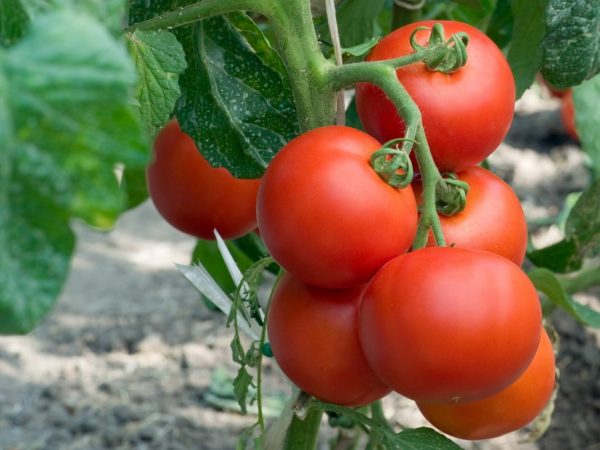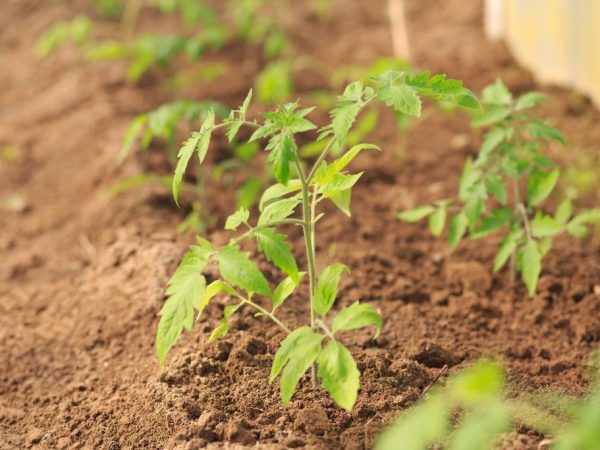Characteristics of the Eupator tomato variety
The country's vegetable growers grow many varieties of vegetables on their plots. Among them are determinant and indeterminate tomatoes. Today, the most common among tomato lovers is the Russian variety of tomato selection Eupator, the brainchild of the selection company Gavrish. It belongs to the indeterminate species, which means that its growth must be limited. The yield of this hybrid is high, the yield of fruits is simultaneous.

Characteristics of the Eupator tomato variety
Description of the variety
The Eupator tomato variety is similar in many ways to other indeterminate type tomatoes.
- Its height can be more than one meter.
- This is a mid-early hybrid f1, of the first generation, which means that the collected seeds, if planted, will not preserve the specific features.
- The bush is most often formed into one stem. If you leave the first stepson, then it is possible to grow a tomato in two stalks.
- The first brush with flowers is located at the level of the ninth leaf.
- The tomato bush is resistant to disease.
As for the height, then, pinching the growth points, it can be limited to 1.8 meters. A tall plant requires a garter to a support or trellis. The description will not be complete, if not to say that the variety has a high resistance to late blight viruses and gray rot.
The stems of the plant are knobby, finely pubescent, and have a pronounced green color. Flower clusters form across two or three leaves, and carry up to 12 flowers. All flowers of the cluster open at the same time. Ripening of fruits does not stretch in time and their collection is carried out from the entire brush.
Fruit characteristics
Eupator tomatoes have rounded fruits that are covered with a shiny skin. At the stage of milky ripeness, they are light green, and they begin to turn red at the same time.
The elastic, dense skin is not prone to cracking, so that the reviews about the f1 Eupator tomatoes are the most positive. The tomato yield is very high, with each fruit weighing about 130g.
If the cultivation is correct, then one square meter will be up to 40 kg of products. All tomatoes are practically the same size, so that they are more than 90% marketable.
Fruit application
Beautiful in appearance, these tomatoes also taste good. This characteristic distinguishes them from other hybrids, which are not always tasty when eaten fresh. They are suitable for consumption:
- in green salads;
- in the form of sauces and ketchups;
- in a canned product;
- in the form of processing into juices and dressing for main courses.
Growing seedlings

The plant is best grown in a greenhouse
To grow healthy seedlings, choose the right soil and soak the seeds in stimulant solutions. The soil must contain the necessary elements for the growth and development of seedlings. It includes humus and ash so that it is crumbly. Growing tomatoes and their subsequent yield depends on the humidity and temperature at which the seedlings grow.For a tomato, 35 degrees of heat is enough, and the humidity should be such that condensation does not occur on the film.
After the appearance of four leaves, the seedlings can be dived and fertilized. Boric acid, mullein and other preparations are suitable for fertilization. It is advisable to treat the plants with a weak solution of potassium permanganate to disinfect the plantings. Foliar dressing with boron will not only help growth, but also scare off small insects
Growing bushes
The characteristic of the variety claims that a certain disadvantage that can make growing tomatoes a problem is that it needs a greenhouse. Only in greenhouses will there be a high and stable yield.
Ready seedlings do not need to be hardened, but simply transplanted into holes filled with a hoe. For this, the rows are marked at a distance of about 70 cm. Between plants in rows, it is optimal to leave up to 50cm.
Ash and, low concentration, fertilizers can be added to the holes. Drizzle with warm water and plant the plants. Supports are installed near each future bush, but it is preferable and easier to pull the trellis. The planted tomatoes are tied up as they grow.
The formation of the bush comes down to the fact that when the first stepson appears, it is left for the second stem. When you reach the height required for the greenhouse, you need to pinch the growth point. All stepchildren, after the first, are removed, as are the leaves near the ground.
Fertilization and care
Fertilizers include solutions of rotted mullein, bird droppings and boric acid. Organic products are added to containers with water, in proportions: one to two. Leave for a couple of weeks, while stirring several times for better fermentation. Then 4 liters of warm water are added to a liter of solution and watered under the root. Boric acid is fertilized according to the instructions, which are always on the back of the bags.
Caring for Eupator tomatoes comes down to the following activities:
- airing greenhouses;
- weeding and loosening the soil;
- pest control;
- protection of plants from diseases.
The description of the rules of care warns that with high humidity there may be a threat of late blight and other viruses. Although tomatoes of this variety are very resistant to them, it is better to carry out prevention than to treat diseased bushes.
Conclusion
From everything written above, as well as based on the reviews of gardeners, we conclude that growing Eupator tomatoes is not burdensome and profitable. With proper agricultural technology, we will get a sufficient yield of fruits. After collecting tomatoes, they can be eaten fresh or processed. Surplus products are available for sale. Therefore, tomatoes of this variety have become popular among owners of private estates and farms.


